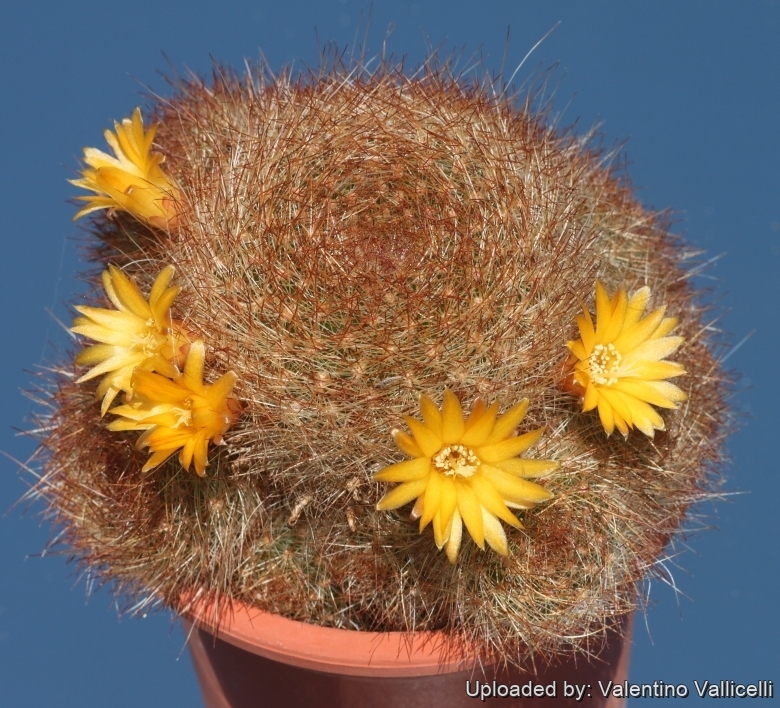= Rebutia glomeriseta Cárdenas
Cact. Succ. J. (Los Angeles) 23: 93. 1951
Accepted Scientific Name: Rebutia arenacea Cárdenas
Cact. Succ. J. (Los Angeles) 23: 94. 1951

Weingartia glomeriseta (Rebutia glomeriseta) Photo by: Valentino Vallicelli
Origin and Habitat: Rebutia glomerisetaSN|15080]]SN|15080]] comes from the border area of Bolivia-Paraguay-Argentina
Type locality: Sucre, Rio Ayopaya Cochabamba, Bolivia.
Altitude: Grows at higher elevations over 1500 meters above sea level.
Synonyms:
See all synonyms of Rebutia arenacea
back
Accepted name in llifle Database:Rebutia arenacea CárdenasCact. Succ. J. (Los Angeles) 23: 94. 1951Synonymy: 26
back
Description: Rebutia glomerisetaSN|15056]]SN|15080]], best known as SulcoSN'> 15082' alt='15064'>Rebutia glomeriseta#SN#15080'>Sulco[[Rebutia glomerisetaSN' style='border:none;'> (Cárdenas) F.Ritter, is a small clustering cactus that produces dense clusters of vivid yellow blooms in spring. The stems can form pups after a certain size and age.
15082' alt='15064'>Rebutia glomeriseta#SN#15080'>Sulco[[Rebutia glomerisetaSN' style='border:none;'> (Cárdenas) F.Ritter, is a small clustering cactus that produces dense clusters of vivid yellow blooms in spring. The stems can form pups after a certain size and age.
Related species: It is closely allied and intergrades with Rebutia menesesiiSN|15080]]SN|15064]] and Rebutia arenaceaSN|15080]]SN|15056]] that grows in the same area. They may all be different forms of the same polymorphic species.
Stem: Flattened-spherical (often becoming somewhat elongate in cultivation), dark green, growing up to 6 cm diameter.
Tubercles: In 15-20 spirals.
Areoles: Oval-elongate about 2-5 mm in diameter and spaced about 3-8 mm.
Spines: Not easily differentiable from radials and centrals, bristly, interlecing creamy yellow to brownish at first, then turning greysh.
Flowers: Golden Yellow to orangish 2,5-3 cm long, 1,5-3,5 cm in diameter; stamens in two series.
Blooming season: Late winter to spring.
Fruits: Reddish brown.
More...Subspecies, varieties, forms and cultivars of plants belonging to the Rebutia arenacea group
 Rebutia arenacea Cárdenas: (Sulcorebutia arenacea) has 14-16, tiny spines, all radials, up to 4(-5) mm long, minutely pubescent whitish, amber or tan, pectinate held tightly that give a sandy effect. Distribution: Cochabamba.
Rebutia arenacea Cárdenas: (Sulcorebutia arenacea) has 14-16, tiny spines, all radials, up to 4(-5) mm long, minutely pubescent whitish, amber or tan, pectinate held tightly that give a sandy effect. Distribution: Cochabamba. Rebutia candiae Cárdenas: (Sulcorebutia arenacea var. candiae) very similar to S. glomeriseta but spines shorter and pectinate bristly, interlecing creamy yellow to brownish. Distribution: border area of Chochabamba.
Rebutia candiae Cárdenas: (Sulcorebutia arenacea var. candiae) very similar to S. glomeriseta but spines shorter and pectinate bristly, interlecing creamy yellow to brownish. Distribution: border area of Chochabamba. Rebutia glomeriseta Cárdenas: (Sulcorebutia glomeriseta) Spines not easily differentiable from radials and centrals, fine, bristly, interlecing creamy yellow to brownish. Distribution: border area of Bolivia-Paraguay-Argentina.
Rebutia glomeriseta Cárdenas: (Sulcorebutia glomeriseta) Spines not easily differentiable from radials and centrals, fine, bristly, interlecing creamy yellow to brownish. Distribution: border area of Bolivia-Paraguay-Argentina.- Rebutia menesesii Cárdenas: (Sulcorebutia arenacea var. menesesii)
- Sulcorebutia arenacea var. kamiensis (Bredero & Donald) Gertel & J.de Vries
- Sulcorebutia muschii R.Vásquez
Bibliography: Major references and further lectures
1) James Cullen, Sabina G. Knees, H. Suzanne Cubey “The European Garden Flora Flowering Plants: A Manual for the Identification of Plants Cultivated in Europe, Both Out-of-Doors and Under Glass” Cambridge University Press, 11/Aug./2011
2) David Hunt, Nigel Taylor “The New Cactus Lexicon” DH Books, 2006
3) Edward F. Anderson “The Cactus Family” Timber Press, 2001
4) Anderson E. F.: "The Cactus Family" Timber Press, Portland, Oregon, 2001
5) Ritter Fr.: "Kakteen in Südamerika" Spangenberg, 1980
6) John Pilbeam "Sulcorebutia and Weingartia: A Collector's Guide" Timber Press, 1985
7) E Haustein “Der Kosmos Kakteenfuehrer (the Kosmos Cactus Guide)” Balogh Scientific Books 01 December 1998
8) Cullmann W., Götz E., Gröner G.”Kakteen: Kultur, Vermehrung und Pflege - Lexikon der Gattungen und Arten” Ulmer, Stuttgart, 1984
More... Weingartia glomeriseta (Rebutia glomeriseta) Photo by: Valentino Vallicelli
Weingartia glomeriseta (Rebutia glomeriseta) Photo by: Valentino Vallicelli Weingartia glomeriseta (Rebutia glomeriseta) Photo by: Valentino Vallicelli
Weingartia glomeriseta (Rebutia glomeriseta) Photo by: Valentino Vallicelli Weingartia glomeriseta (Rebutia glomeriseta) Photo by: Valentino Vallicelli
Weingartia glomeriseta (Rebutia glomeriseta) Photo by: Valentino Vallicelli Weingartia glomeriseta (Rebutia glomeriseta) Photo by: Valentino Vallicelli
Weingartia glomeriseta (Rebutia glomeriseta) Photo by: Valentino Vallicelli Weingartia glomeriseta (Rebutia glomeriseta) Photo by: Valentino Vallicelli
Weingartia glomeriseta (Rebutia glomeriseta) Photo by: Valentino Vallicelli Weingartia glomeriseta (Rebutia glomeriseta) Photo by: Valentino Vallicelli
Weingartia glomeriseta (Rebutia glomeriseta) Photo by: Valentino Vallicelli Weingartia glomeriseta (Rebutia glomeriseta) Photo by: Valentino Vallicelli
Weingartia glomeriseta (Rebutia glomeriseta) Photo by: Valentino Vallicelli Weingartia glomeriseta (Rebutia glomeriseta) Photo by: Valentino Vallicelli
Weingartia glomeriseta (Rebutia glomeriseta) Photo by: Valentino VallicelliCultivation and Propagation: These mountainous plants have thick taproots and are susceptible to overwatering. They loves a very permeable, coarse mineral soil as well as to be strictly kept dry throughout the winter quiescent period since it is very sensitive to any moisture excesses, To prevent rottenness it is also advisable to surround its root neck by very rough sand or grit, this help a fast water drainage. They requires also an appropriate air circulation and are sometime grafted to avoid root problems. They need to be kept in a cool place during winter rest (at 0-10°C). This is important for the flowers ,as well as for their health. Without this cool winter period, they normally won't get any buds.
Grafted plants are very easy to grow, and are quite frost hardy (-5° C) if kept dry. Needs a full sun exposure ( light shadow my be useful in the hottest summer days)
Propagation: Seed, cutting, grafting.
More...


















